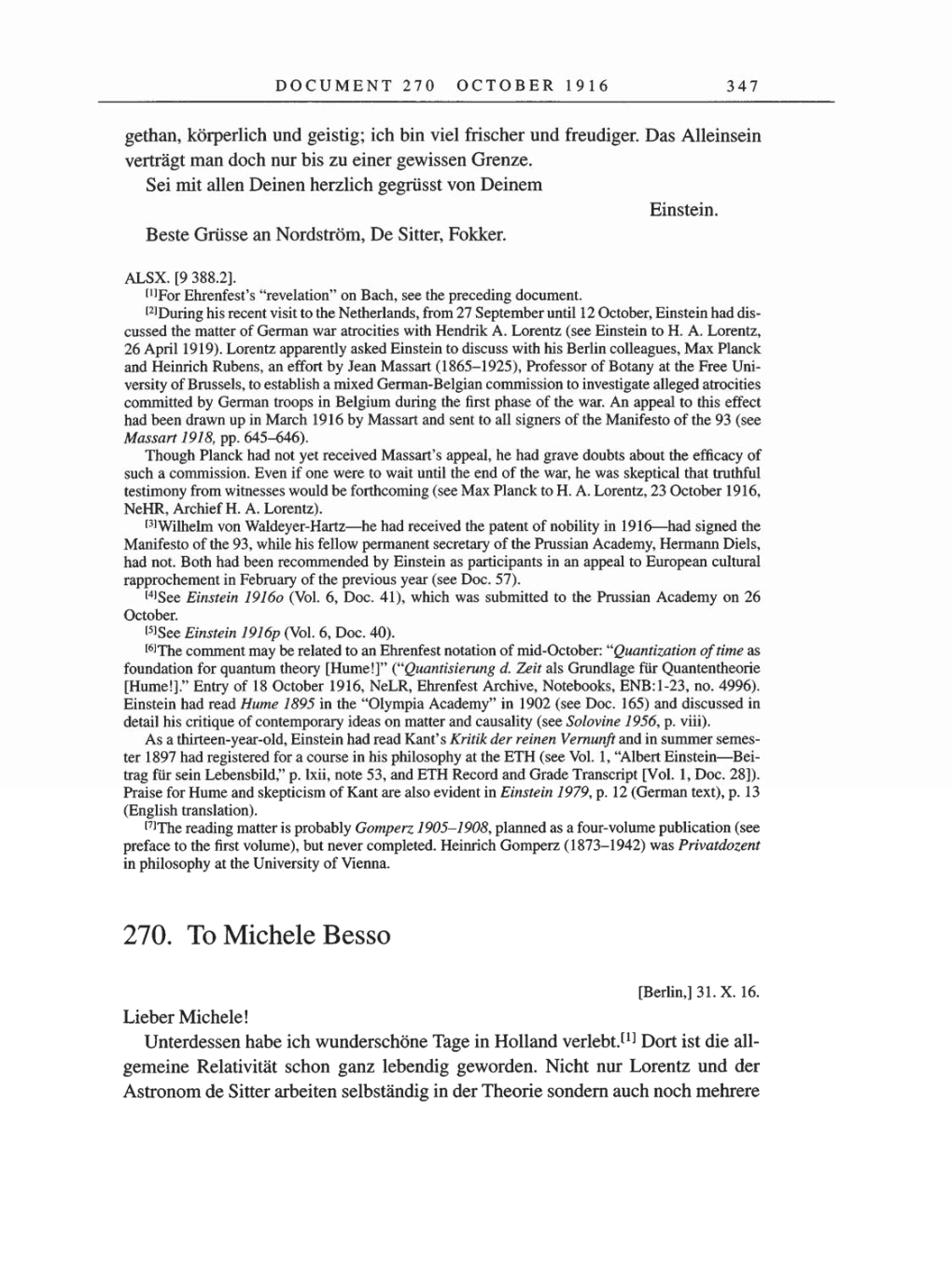DOCUMENT 270 OCTOBER
1916
347
gethan,
körperlich
und
geistig;
ich bin
viel
frischer und
freudiger.
Das
Alleinsein
verträgt man
doch
nur
bis
zu
einer
gewissen
Grenze.
Sei mit allen Deinen
herzlich
gegrüsst von
Deinem
Einstein.
Beste Grüsse
an
Nordstrom,
De
Sitter,
Fokker.
ALSX.
[9 388.2].
[1]For
Ehrenfest’s “revelation”
on
Bach,
see
the
preceding
document.
[2]During
his recent visit to the
Netherlands,
from 27
September
until
12 October,
Einstein
had dis-
cussed the matter
of
German
war
atrocities with Hendrik A.
Lorentz
(see
Einstein to H. A.
Lorentz,
26
April 1919).
Lorentz
apparently
asked Einstein to discuss with his Berlin
colleagues,
Max Planck
and
Heinrich
Rubens,
an
effort
by
Jean Massart (1865-1925),
Professor of
Botany
at
the Free
Uni-
versity
of
Brussels,
to establish
a
mixed
German-Belgian
commission
to
investigate alleged
atrocities
committed
by
German
troops
in
Belgium during
the first
phase
of
the
war.
An
appeal
to this effect
had
been
drawn
up
in March 1916
by
Massart and sent to all
signers
of
the Manifesto
of
the 93
(see
Massart
1918, pp.
645-646).
Though
Planck
had
not
yet
received Massart’s
appeal,
he had
grave
doubts
about the
efficacy
of
such
a
commission.
Even
if
one were
to wait until the end
of
the
war,
he
was skeptical
that
truthful
testimony
from
witnesses would
be
forthcoming (see
Max
Planck
to H. A.
Lorentz,
23
October
1916,
NeHR,
Archief
H.
A.
Lorentz).
[3]Wilhelm
von
Waldeyer-Hartz-he
had received the patent
of
nobility
in 1916-had
signed
the
Manifesto
of
the
93,
while his fellow
permanent secretary
of
the Prussian
Academy,
Hermann
Diels,
had not. Both had been
recommended
by
Einstein
as
participants
in
an appeal
to European
cultural
rapprochement
in
February
of
the
previous year
(see
Doc.
57).
[4]
See Einstein 1916o
(Vol. 6,
Doc.
41),
which
was
submitted
to the Prussian
Academy
on
26
October.
[5]See
Einstein
1916p
(Vol. 6,
Doc.
40).
[6]The comment
may
be related to
an
Ehrenfest notation
of
mid-October:
“Quantization
of time
as
foundation
for
quantum theory [Hume!]”
(“Quantisierung d.
Zeit als
Grundlage
für
Quantentheorie
[Hume!].” Entry
of
18
October
1916, NeLR,
Ehrenfest
Archive, Notebooks, ENB:1-23,
no.
4996).
Einstein
had read Hume
1895 in the
“Olympia Academy”
in 1902
(see
Doc.
165)
and
discussed
in
detail his
critique
of
contemporary
ideas
on
matter and
causality (see
Solovine
1956,
p. viii).
As
a
thirteen-year-old,
Einstein
had read Kant’s Kritik
der
reinen
Vernunft
and in
summer semes-
ter 1897 had
registered
for
a course
in his
philosophy
at
the
ETH
(see
Vol.
1,
“Albert
Einstein-Bei-
trag
für
sein
Lebensbild,”
p.
lxii,
note
53,
and
ETH Record
and
Grade
Transcript [Vol. 1,
Doc.
28]).
Praise for Hume and
skepticism
of
Kant
are
also
evident in
Einstein
1979,
p.
12
(German text), p.
13
(English
translation).
[7]The
reading
matter is
probably
Gomperz
1905-1908,
planned
as a
four-volume
publication (see
preface
to the first
volume),
but
never completed.
Heinrich
Gomperz
(1873-1942)
was
Privatdozent
in
philosophy
at the
University
of
Vienna.
270.
To
Michele Besso
[Berlin,]
31. X.
16.
Lieber
Michele!
Unterdessen
habe ich
wunderschöne
Tage
in Holland
verlebt.[1]
Dort
ist
die all-
gemeine
Relativität schon
ganz lebendig geworden.
Nicht
nur
Lorentz
und der
Astronom
de Sitter arbeiten
selbständig
in
der
Theorie
sondern
auch noch mehrere
